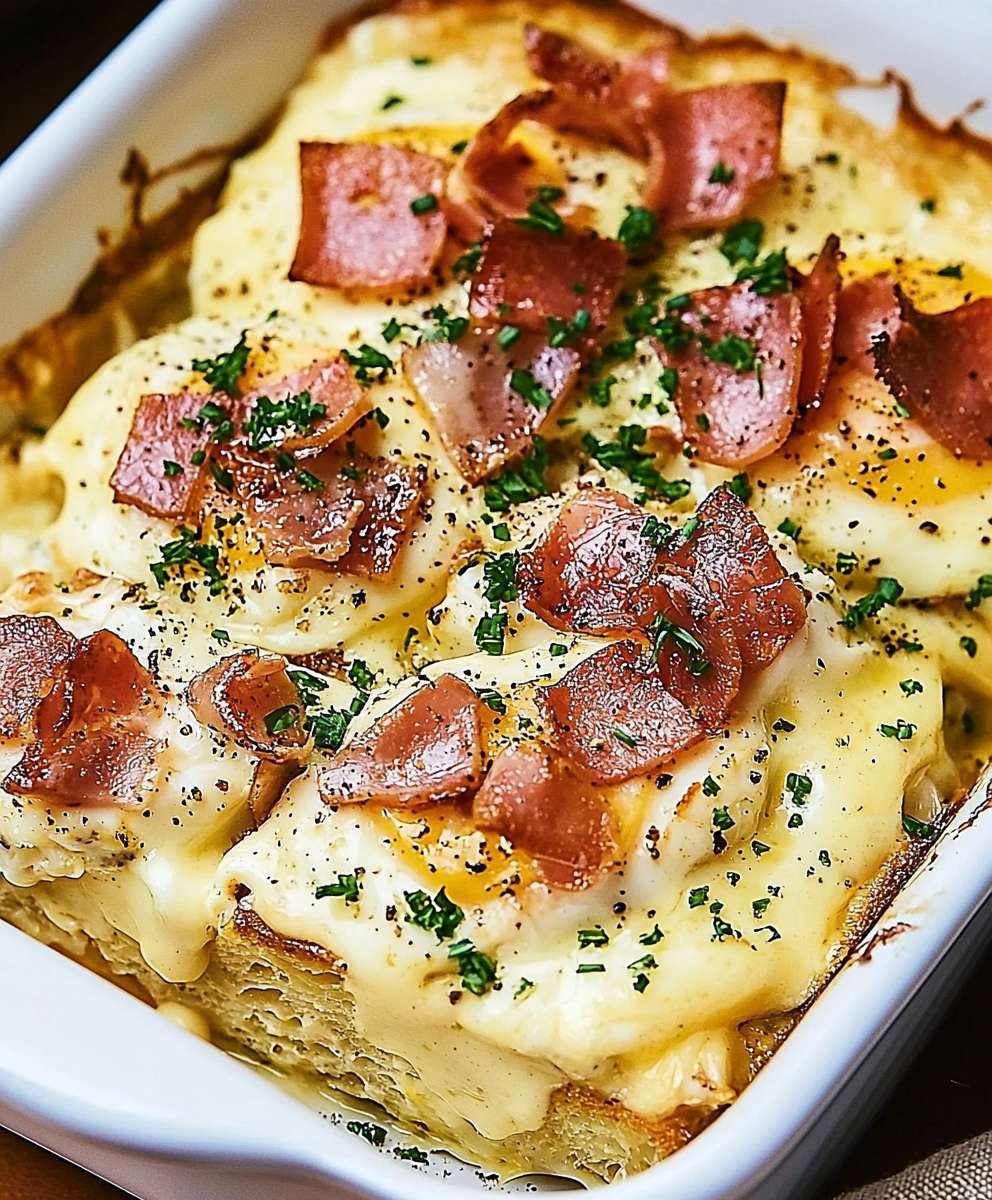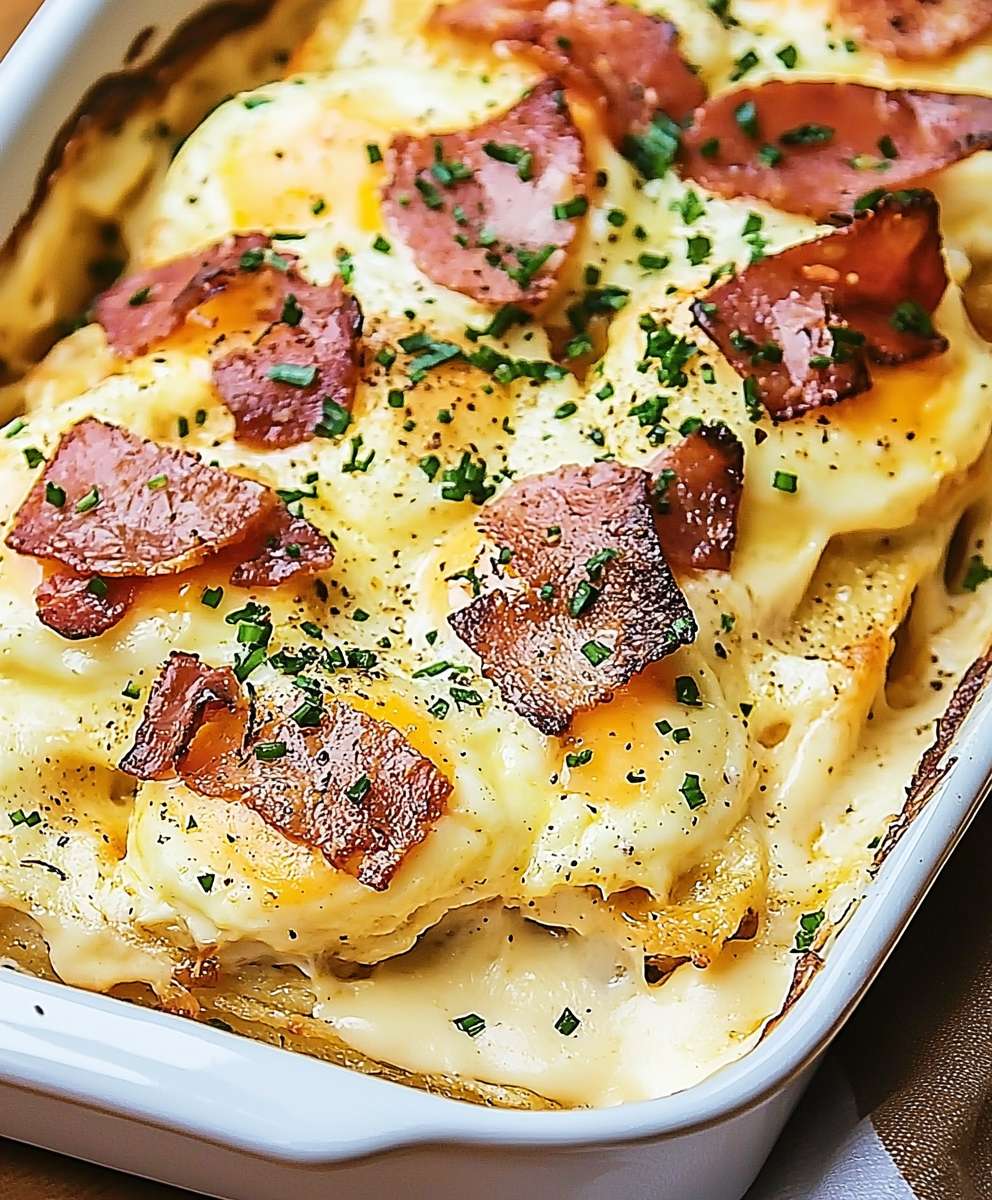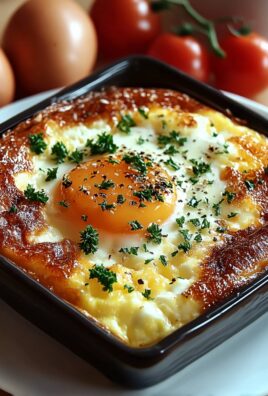Eggs Benedict Casserole: the brunch game-changer you never knew you needed! Imagine waking up on a lazy Sunday morning to the aroma of toasted English muffins, savory ham, and a rich, creamy hollandaise sauce, all baked to golden perfection in one easy-to-serve dish. Forget slaving over a hot stove, poaching eggs one by one this casserole delivers all the classic flavors of Eggs Benedict without the fuss.
While the exact origins of Eggs Benedict are debated (with stories swirling around New York City’s Waldorf Hotel and Delmonico’s Restaurant in the late 19th century), its enduring appeal is undeniable. It’s a dish that speaks of indulgence and leisurely mornings, a perfect blend of textures and tastes that has captivated brunch enthusiasts for generations. The combination of the crisp muffin, salty ham, perfectly cooked egg, and velvety hollandaise is simply irresistible.
But let’s be honest, making traditional Eggs Benedict can be a bit intimidating. That’s where this Eggs Benedict Casserole comes in! It captures all the magic of the original in a simplified, crowd-pleasing format. People adore this dish because it’s incredibly flavorful, satisfying, and, most importantly, convenient. It’s perfect for feeding a crowd, potlucks, or even a special breakfast for the family. Get ready to impress with this effortless and delicious brunch staple!
Ingredients:
- 1 loaf (1 pound) French bread, cut into 1-inch cubes
- 1 pound thick-cut bacon, cooked and crumbled
- 1 cup shredded Gruyere cheese
- 1 cup shredded Swiss cheese
- 6 large eggs
- 3 cups milk
- 1/2 cup heavy cream
- 1/4 cup Dijon mustard
- 1 tablespoon Worcestershire sauce
- 1/2 teaspoon salt
- 1/4 teaspoon black pepper
- 1/4 teaspoon cayenne pepper (optional)
- 1/2 cup (1 stick) unsalted butter
- 1/4 cup all-purpose flour
- 3 cups milk
- 1/4 teaspoon salt
- 1/8 teaspoon white pepper
- 4 large egg yolks
- 2 tablespoons lemon juice
- 1/4 teaspoon hot sauce (optional)
- 4 English muffins, split and toasted
- 8 poached eggs
- Fresh chives, chopped, for garnish
Preparing the Casserole Base:
- Prepare the Bread and Bacon: First, you’ll want to cube your French bread. I like to use a serrated knife for this to get nice, even pieces. Spread the bread cubes on a baking sheet and let them sit out for a few hours to dry out slightly. This helps them absorb the custard better and prevents the casserole from becoming soggy. While the bread is drying, cook your bacon until it’s nice and crispy. I prefer to bake my bacon in the oven at 400°F (200°C) for about 15-20 minutes, but you can also cook it in a skillet. Once the bacon is cooked, drain off any excess grease and crumble it into small pieces.
- Combine the Bread, Bacon, and Cheese: In a large bowl, combine the dried bread cubes, crumbled bacon, Gruyere cheese, and Swiss cheese. Toss everything together until it’s evenly distributed. The combination of Gruyere and Swiss gives a wonderful nutty and slightly tangy flavor to the casserole.
- Prepare the Custard: In a separate large bowl, whisk together the eggs, milk, heavy cream, Dijon mustard, Worcestershire sauce, salt, black pepper, and cayenne pepper (if using). Make sure everything is well combined. The Dijon mustard adds a nice tang, and the Worcestershire sauce gives it a savory depth. The cayenne pepper is optional, but I like a little kick!
- Assemble the Casserole: Grease a 9×13 inch baking dish. Pour the bread, bacon, and cheese mixture into the prepared baking dish, spreading it out evenly. Pour the custard mixture over the bread mixture, making sure to saturate all the bread cubes. Gently press down on the bread to ensure it’s fully submerged in the custard.
- Refrigerate Overnight (Recommended): For the best results, cover the casserole with plastic wrap and refrigerate it overnight. This allows the bread to fully absorb the custard, resulting in a richer and more flavorful casserole. If you’re short on time, you can let it sit for at least 30 minutes, but overnight is ideal.
Making the Hollandaise Sauce:
- Melt the Butter: In a small saucepan, melt the butter over medium heat. Cook until the butter is melted and slightly foamy. Be careful not to burn the butter.
- Prepare the Roux: Whisk in the flour into the melted butter and cook for 1-2 minutes, stirring constantly, until a smooth paste forms. This is called a roux, and it will help thicken the sauce.
- Whisk in the Milk: Gradually whisk in the milk, a little at a time, until the roux is completely dissolved and the mixture is smooth. Continue whisking constantly to prevent lumps from forming.
- Simmer the Sauce: Bring the sauce to a simmer over medium heat, stirring constantly. Reduce the heat to low and simmer for 5-7 minutes, or until the sauce has thickened slightly. Season with salt and white pepper. White pepper adds a subtle flavor without the black specks.
- Temper the Egg Yolks: In a separate bowl, whisk together the egg yolks. Slowly drizzle a small amount of the hot milk mixture into the egg yolks, whisking constantly to temper them. This prevents the eggs from scrambling when you add them to the hot sauce.
- Combine the Egg Yolks and Sauce: Pour the tempered egg yolk mixture into the saucepan with the milk sauce. Whisk constantly over low heat until the sauce has thickened to a creamy consistency. Be careful not to overheat the sauce, or the eggs will scramble.
- Finish the Sauce: Remove the saucepan from the heat and stir in the lemon juice and hot sauce (if using). The lemon juice adds a bright, tangy flavor, and the hot sauce gives it a little extra kick. Taste and adjust the seasoning as needed.
- Keep Warm: Keep the Hollandaise sauce warm in a double boiler or a heatproof bowl set over a pot of simmering water. Be sure to stir it occasionally to prevent a skin from forming.
Cooking and Assembling the Casserole:
- Preheat the Oven: Preheat your oven to 350°F (175°C).
- Bake the Casserole: Remove the casserole from the refrigerator and bake it in the preheated oven for 45-55 minutes, or until it’s golden brown and set. A knife inserted into the center should come out clean. If the top starts to brown too quickly, you can tent it with foil.
- Poach the Eggs: While the casserole is baking, poach your eggs. Fill a large saucepan with about 3 inches of water and bring it to a simmer. Add a splash of vinegar to the water, which helps the egg whites coagulate. Crack each egg into a small bowl, then gently slide it into the simmering water. Cook for 3-4 minutes, or until the whites are set and the yolks are still runny. Remove the eggs with a slotted spoon and place them on a paper towel-lined plate to drain.
- Toast the English Muffins: Toast the English muffins until they are golden brown.
- Assemble the Eggs Benedict Casserole: Cut the baked casserole into squares. Place a toasted English muffin half on each plate. Top with a square of the casserole, a poached egg, and a generous spoonful of Hollandaise sauce.
- Garnish and Serve: Garnish with fresh chopped chives and serve immediately. The chives add a pop of color and a fresh, oniony flavor.

Conclusion:
This Eggs Benedict Casserole isn’t just a recipe; it’s a brunch game-changer! Seriously, if you’re looking for a way to impress your guests (or just treat yourself to something truly special), you absolutely have to give this a try. The creamy hollandaise, the savory ham, the perfectly baked eggs it all comes together in a symphony of flavors that will have everyone begging for seconds. And the best part? It’s surprisingly easy to make, especially compared to the traditional, individual-serving version of Eggs Benedict.
Think about it: no more poaching eggs one at a time, no more struggling to keep the hollandaise warm. This casserole streamlines the whole process, allowing you to enjoy the same incredible taste with a fraction of the effort. It’s the perfect solution for a stress-free brunch, a holiday gathering, or even a special weeknight dinner.
But don’t just take my word for it! Imagine serving this warm, bubbly casserole alongside a fresh fruit salad and a mimosa bar. Or, for a heartier meal, pair it with some crispy breakfast potatoes and a side of bacon. The possibilities are endless!
And speaking of possibilities, feel free to get creative with the variations. Want to add a little spice? Try using chorizo instead of ham. Vegetarian? Substitute the ham with sautéed spinach and mushrooms. Feeling adventurous? Add a layer of sliced tomatoes or asparagus. The beauty of this Eggs Benedict Casserole is that it’s incredibly versatile and can be easily adapted to suit your taste preferences.
For a richer flavor, consider using Gruyere cheese instead of cheddar. Or, if you’re feeling fancy, top the casserole with a sprinkle of fresh chives or a drizzle of truffle oil before serving. You could even add a dash of hot sauce to the hollandaise for a little kick.
I’m telling you, once you try this recipe, you’ll wonder how you ever lived without it. It’s become a staple in my own brunch rotation, and I’m confident it will become one of yours too. It’s the perfect make-ahead dish, allowing you to prepare it the night before and simply pop it in the oven when you’re ready to bake. This makes it ideal for busy mornings or when you’re entertaining a crowd.
So, what are you waiting for? Gather your ingredients, preheat your oven, and get ready to experience the magic of this incredible Eggs Benedict Casserole. I promise you won’t be disappointed.
And once you’ve tried it, I’d love to hear about your experience! Share your photos, your variations, and your thoughts in the comments below. Let me know what you loved about it, what you changed, and how you made it your own. I’m always looking for new ideas and inspiration, and I can’t wait to see what you come up with. Happy cooking! I hope you enjoy this recipe as much as I do. Don’t forget to rate the recipe after you try it!
Eggs Benedict Casserole: The Ultimate Brunch Recipe
Layers of French bread, bacon, Gruyere, and Swiss cheese baked in a rich custard, topped with poached eggs and homemade Hollandaise sauce.
Ingredients
- 1 loaf (1 pound) French bread, cut into 1-inch cubes
- 1 pound thick-cut bacon, cooked and crumbled
- 1 cup shredded Gruyere cheese
- 1 cup shredded Swiss cheese
- 6 large eggs
- 3 cups milk (for custard)
- 1/2 cup heavy cream
- 1/4 cup Dijon mustard
- 1 tablespoon Worcestershire sauce
- 1/2 teaspoon salt (for custard)
- 1/4 teaspoon black pepper
- 1/4 teaspoon cayenne pepper (optional)
- 1/2 cup (1 stick) unsalted butter
- 1/4 cup all-purpose flour
- 3 cups milk (for hollandaise)
- 1/4 teaspoon salt (for hollandaise)
- 1/8 teaspoon white pepper
- 4 large egg yolks
- 2 tablespoons lemon juice
- 1/4 teaspoon hot sauce (optional)
- 4 English muffins, split and toasted
- 8 large eggs (for poaching)
- Fresh chives, chopped, for garnish
Instructions
- Prepare the Bread and Bacon: Cube French bread and let dry for a few hours. Cook bacon until crispy, drain, and crumble.
- Combine the Bread, Bacon, and Cheese: In a large bowl, combine dried bread cubes, crumbled bacon, Gruyere cheese, and Swiss cheese. Toss to distribute evenly.
- Prepare the Custard: In a separate bowl, whisk together eggs, milk, heavy cream, Dijon mustard, Worcestershire sauce, salt, black pepper, and cayenne pepper (if using).
- Assemble the Casserole: Grease a 9×13 inch baking dish. Pour the bread, bacon, and cheese mixture into the dish. Pour the custard mixture over the bread mixture, ensuring all bread is saturated. Gently press down.
- Refrigerate Overnight (Recommended): Cover with plastic wrap and refrigerate overnight for best results. If short on time, let sit for at least 30 minutes.
- Melt the Butter: In a small saucepan, melt butter over medium heat until foamy.
- Prepare the Roux: Whisk in flour and cook for 1-2 minutes, stirring constantly, until a smooth paste forms.
- Whisk in the Milk: Gradually whisk in milk, a little at a time, until the roux is completely dissolved and the mixture is smooth.
- Simmer the Sauce: Bring the sauce to a simmer over medium heat, stirring constantly. Reduce heat to low and simmer for 5-7 minutes, or until thickened. Season with salt and white pepper.
- Temper the Egg Yolks: In a separate bowl, whisk egg yolks. Slowly drizzle a small amount of the hot milk mixture into the egg yolks, whisking constantly.
- Combine the Egg Yolks and Sauce: Pour the tempered egg yolk mixture into the saucepan with the milk sauce. Whisk constantly over low heat until the sauce has thickened to a creamy consistency.
- Finish the Sauce: Remove from heat and stir in lemon juice and hot sauce (if using). Taste and adjust seasoning.
- Keep Warm: Keep Hollandaise warm in a double boiler or heatproof bowl over simmering water, stirring occasionally.
- Preheat the Oven: Preheat oven to 350°F (175°C).
- Bake the Casserole: Remove casserole from refrigerator and bake for 45-55 minutes, or until golden brown and set. A knife inserted into the center should come out clean. Tent with foil if browning too quickly.
- Poach the Eggs: While casserole bakes, poach eggs. Simmer water in a saucepan with a splash of vinegar. Crack eggs into a bowl, then gently slide into simmering water. Cook for 3-4 minutes, or until whites are set and yolks are runny. Remove with a slotted spoon and drain on paper towels.
- Toast the English Muffins: Toast English muffins until golden brown.
- Assemble the Eggs Benedict Casserole: Cut casserole into squares. Place a toasted English muffin half on each plate. Top with a casserole square, a poached egg, and Hollandaise sauce.
- Garnish and Serve: Garnish with fresh chopped chives and serve immediately.
Notes
- Refrigerating the casserole overnight allows the bread to fully absorb the custard, resulting in a richer and more flavorful dish.
- Be careful not to overheat the Hollandaise sauce, or the eggs will scramble.
- Keep the Hollandaise sauce warm until serving to prevent it from separating.
- Adjust the amount of cayenne pepper and hot sauce to your preference.






Leave a Comment